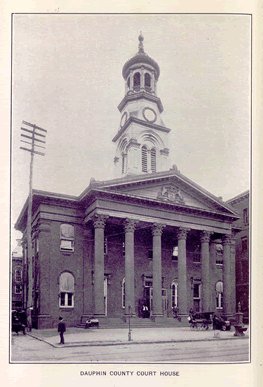Harrisburg on the eve of Civil War
Study Areas
Dauphin County Courthouses
Anti-Slavery Activities on Market Street, Harrisburg
John Harris' 1785 plan for Harrisburg set aside public ground for a courthouse on Market Street and, connecting at the rear of the lot, a jail on Walnut Street. The first Dauphin County Courthouse was built on the corner of Market Street and Rasberry Alley (modern day Court Street) between 1792 and 1799. It was a plain brick building, with a bell that was rung for fires as well as for public elections and church services.
The early courthouse housed the State legislature until architect Stephen HIlls completed the State Capitol, and the county relocated to a building on the corner opposite to the jail. By 1822 the county was back in the courthouse, which Hills had enlarged (for the legislators) by adding a two-story addition to the front.
It was in front of this enlarged building that Harrisburg witnessed its first anti-slavery riot, on April 21, 1825, as a crowd of African American men "armed with clubs and cudgels," confronted several Maryland men who had captured an African American man in Harrisburg as a fugitive slave. In the melee that erupted, one of the Harrisburg rioters was shot in the arm and sixteen African American men were arrested by county sheriff Captain Thomas Walker. Walker had commanded the Harrisburg Volunteers, a military company that marched to the defense of Baltimore in 1814.
In April 1845, American Anti-Slavery Society speakers Abby Kelley and Jane Hitchcock were booked into the Courthouse for speeches. The women's speeches were disrupted by firecrackers and rotten eggs. Both women were threatened with a tar and feathering if they did not immediatley leave Harrisburg. Despite the threats, Kelley returned in March 1848 to speak again in this same location.
A more famous and violent incident occurred in August 1847 when William Lloyd Garrison and Frederick Douglass attempted to address a crowd at the Courthouse. Garrison was able to speak, but when Frederick Douglass, who would have been the first Afican American to publicly address a white audience in the Courthouse, rose to speak, rowdies in the crowd pelted the speakers with rotten eggs and bricks, effectively breaking up the meeting.
The old brick Courthouse was replaced just before the Civil War, in the year that Harrisburg became a city. It was designed by architects Samuel Holman and Daniel E. Wilt, and featured an impressive brownstone Corinthian facade. It was finished in November 1861. During the Confederate invasion of June 1863, white citizens gathered here to plan the defense of Harrisburg. On Monday morning, June 29, 1963, forty-two Confederate prisoners were lined up in the courtyard between the Courthouse and the prison where they were questioned by the local Provost Marshal's office. During this same period, groups of African American refugees from the Cumberland Valley encamped around the Courthouse, until shelter and aid could be found for them with Harrisburg's African American residents.
Previous Next
![]()
![]()
All photographs and text on this page copyright © 2010 George F. Nagle and Afrolumens Project.
Notes and Links
- Historical Marker Database page (old Courthouse)
- Historical Marker Database page (modern Courthouse)
- Read about the 1825 Attempt to free runaway slaves
- More about Abby Kelley and Jane Hitchcock speeches in Harrisburg
- Full story of Frederick Douglass and William Lloyd Garrison in Harrisburg
Of Interest Nearby



